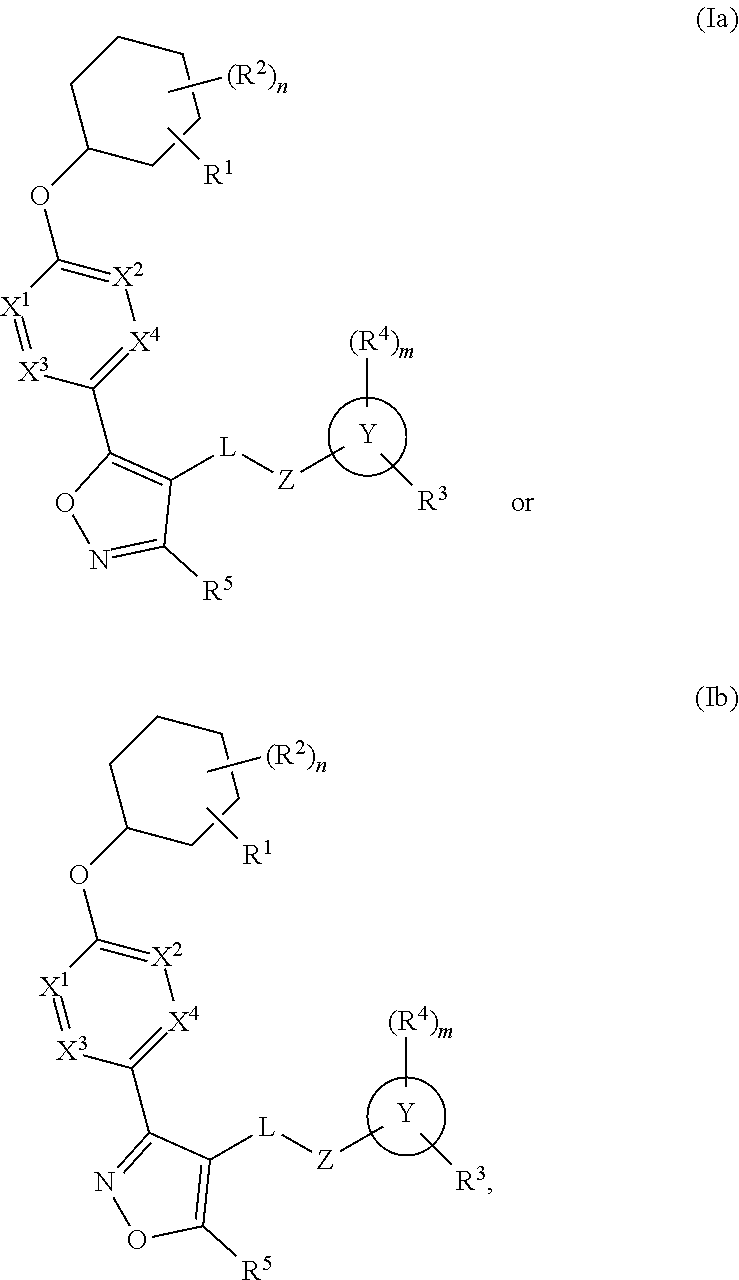Cyclohexyl acid isoxazole azoles as LPA antagonists
a technology of cyclohexyl acid isoxazole and azole, which is applied in the field of new substituted isoxazole compounds, can solve problems such as end-organ failur
- Summary
- Abstract
- Description
- Claims
- Application Information
AI Technical Summary
Benefits of technology
Problems solved by technology
Method used
Image
Examples
example 1
[0551]To a solution of 5-propyl-1,3,4-thiadiazol-2-amine (7 mg, 0.046 mmol) in THE (0.5 mL) was added NaH (3 mg of a 60% suspension in oil, 0.03 mmol). The reaction mixture was stirred at RT for 10 min, after which 1F (10 mg, 0.023 mmol) in THF (0.2 mL) was added. The reaction mixture was stirred at RT for 4 h, after which MeOH (0.5 mL) and aq. LiOH.H2O (19 mg, 0.46 mmol) in H2O (0.5 mL) was added. The reaction was stirred at RT for 14 h, then was concentrated in vacuo. The residue was taken up in EtOAc (2 mL) / H2O (1 mL), and the solution was adjusted to pH 4-5 with 1N aq. HCl. The mixture was extracted with EtOAc (3×2 mL); the combined organic extracts were dried (MgSO4) and concentrated in vacuo. The residue was dissolved in DMF and purified via preparative LC / MS: Column: XBridge C18, 19×200 mm, 5-μm particles; Mobile Phase A: 5:95 MeCN:H2O with 10 mM NH4OAc; Mobile Phase B: 95:5 MeCN:H2O with 10 mM NH4OAc; Gradient: 15-55% B over 19 min, then a 5-min hold at 100% B; Flow: 20 mL / m...
example 2
[0560]To a RT solution of 2C (15 mg, 0.039 mmol), 2-phenyl-2H-1,2,3-triazol-4-amine (9.33 mg, 0.058 mmol) in DCM (0.5 mL) was added Ti(OiPr)3Cl (0.021 mL, 0.078 mmol). The reaction was stirred for 2 h at RT, then NaBH(OAc)3 (17 mg, 0.078 mmol) and TFA (0.018 mL, 0.233 mmol) were added. The reaction mixture was stirred at RT for 18 h, after which satd aq. NaHCO3 was added. The aqueous layer was extracted with EtOAc (3×). The combined organic extracts were washed with brine, dried (MgSO4) and concentrated in vacuo. The crude residue was chromatographed (4 g SiO2; continuous gradient from 0% to 100% EtOAc in Hexane over 10 min) to give the isoxazole-triazole cyclohexyl ester as a clear oil. This cyclohexyl ester was stirred with 1.0 M aq. NaOH (0.542 mL, 0.54 mmol) in THF (1 mL) / MeOH (0.2 mL) at RT for 18 h, then was concentrated in vacuo. The crude product was purified by preparative LCMS (Column: XBridge C18, 19×200 mm, 5-μm particles; Mobile Phase A: 5:95 MeCN:H2O with 0.1% TFA; Mob...
PUM
| Property | Measurement | Unit |
|---|---|---|
| temperature | aaaaa | aaaaa |
| concentration | aaaaa | aaaaa |
| time | aaaaa | aaaaa |
Abstract
Description
Claims
Application Information
 Login to View More
Login to View More - R&D Engineer
- R&D Manager
- IP Professional
- Industry Leading Data Capabilities
- Powerful AI technology
- Patent DNA Extraction
Browse by: Latest US Patents, China's latest patents, Technical Efficacy Thesaurus, Application Domain, Technology Topic, Popular Technical Reports.
© 2024 PatSnap. All rights reserved.Legal|Privacy policy|Modern Slavery Act Transparency Statement|Sitemap|About US| Contact US: help@patsnap.com










